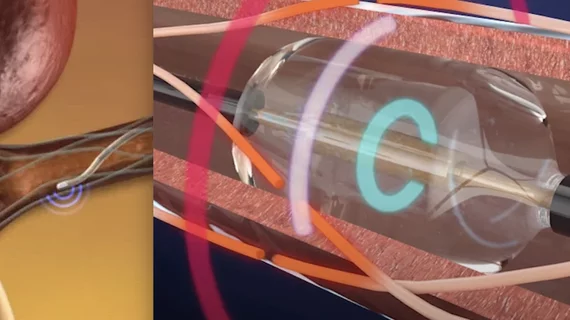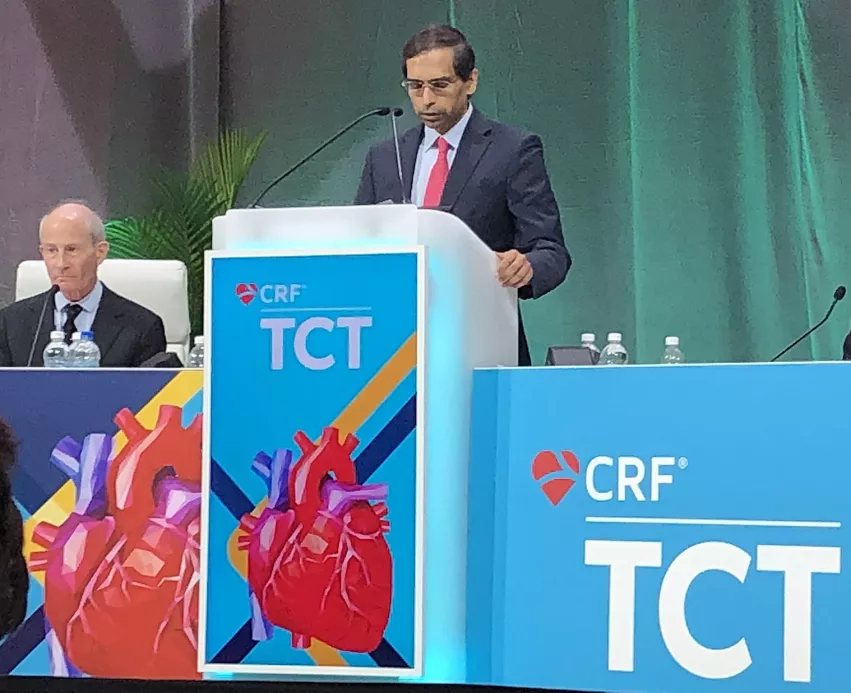Renal denervation lowered blood pressure in two late-breaking TCT trials
Two key, late-breaking studies found renal denervation using two different systems lowered blood pressure in patients with drug treatment resistant hypertension at the 2022 Transcatheter Cardiovascular Therapeutics (TCT) meeting. This may help breath new life into renal denervation development after earlier trials showed questionable efficacy.
Recor ultrasound renal denervation lowers blood pressure effectively in pivotal RADIANCE II trial
The ReCor Medical RADIANCE II U.S. FDA IDE pivotal trial evaluating the Paradise Ultrasound Renal Denervation (uRDN) System showed statistically and clinically significant reductions in blood pressure (BP). The results show uRDN was superior in lowering BP compared with a sham procedure. The change in ASBP was -7.9 mmHg for the uRDN group compared to -1.8 mmHg for the sham group.
“The pivotal RADIANCE II trial is the largest individually powered randomized study to confirm the superiority of endovascular uRDN in lowering blood pressure compared to a sham procedure,” said Ajay J. Kirtane, MD, SM, professor of medicine, Columbia University Irving Medical Center, director, cardiac catheterization laboratories, New York-Presbyterian/Columbia University Irving Medical Center and chief academic officer, Columbia Interventional Cardiovascular Care, said in a statement. “These positive outcomes build upon prior trial results demonstrating that uRDN lowers blood pressure across the spectrum of hypertension. This is an important next step in providing optimal care for patients and we look forward to continuing research to determine whether the blood pressure lowering effect of uRDN remains durable and safe over time.”
Although uRDN has been shown to lower BP in patients with both mild-to-moderate hypertension (HTN) and HTN resistant to a triple combination pill, the sample sizes of prior trials have been limited. RADIANCE II is the largest individually powered randomized trial designed to determine the safety and effectiveness of uRDN among patients with uncontrolled mild-to-moderate hypertension
Patients with HTN (seated office BP ≥140/90 mmHg and <180/120 mmHg) on no more than two anti-HTN medications underwent a four-week observation time during which they were taken off all HTN medications. Those who remained clinically stable after the observation period and whose BP remained elevated with daytime ambulatory systolic BP (ASBP) greater than or equal to 135/85 mmHg but less than 170/105 mmHg underwent anatomic screening with CTA/MRA. Those with qualifying renal artery anatomy proceeded to renal angiography, and if angiography re-confirmed suitability for uRDN, they were then randomized 2:1 to receive bilateral uRDN of the main and accessory (≥3 mm) renal arteries or a sham procedure.
Between March 2019 and May 2022, a total of 150 patients received uRDN and 74 underwent a sham procedure. Baseline characteristics including ambulatory blood pressure and the number of anti-hypertensive medications were similar between both groups. The primary efficacy endpoint was the change in ASBP at two months.
The between-group difference was -6.3 mmHg (95%CI, -9.3 to -3.2, p<0.0001. In addition, the secondary efficacy endpoints of change in 24-hour, nighttime, home and office systolic blood pressure showed statistically and clinically significant reductions (∆5-7 mmHg versus sham). There were also no major adverse events in either group through 30 days.
“The results from RADIANCE II provide further evidence for uRDN as a potential therapy option for hypertension. The RADIANCE II results are strongly consistent across all measures of blood pressure within the study and are also consistent with the prior SOLO (off-medication) and TRIO (on triple antihypertensive combination treatment) trials—adding confidence in the treatment effect of the Paradise uRDN system across a broad spectrum of hypertension severity," explained study principal investigator Michel Azizi, professor of medicine at Université Paris Cité, Hôpital Européen Georges Pompidou, Paris, France, in a statement from the vendor.
"These results align well with the recent consensus statement from the European Society of Cardiology (ESC), supporting the use of renal denervation for treatment of uncontrolled hypertension" Azizi continued. "Additionally, if these results are maintained over the long-term—as already shown by the 36-month results of the SOLO trial and 24-month results of the TRIO trial—the reductions in blood pressure seen in the RADIANCE trials are of a magnitude previously shown in hypertension drug trials to be associated with cardiovascular risk reduction.”
Medtronic SYMPLICITY HTN-3 trial long-term results showed unexpected sustained blood pressure reductions
The long-term results from the SYMPLICITY HTN-3 clinical trial were also presented at TCT. The study found patients who underwent radiofrequency renal denervation (RF RDN) with the first generation Medtronic Symplicity renal denervation system had a statistically significant reduction in office and ambulatory blood pressure compared to subjects in the sham control group. The study was published simultaneously in The Lancet.[1]
"In this long-term follow-up from the SYMPLICITY HTN-3 trial, we observed significant reductions in the blood pressures of patients who underwent treatment with renal denervation, with no long-term complications emerging from this minimally invasive procedure," said Deepak L. Bhatt, MD, MPH, executive director of interventional cardiovascular programs at Brigham and Women's Hospital and professor of medicine at Harvard Medical School, in a statement. He is also the co-principal investigator for the SYMPLICITY HTN-3 trial.
"These findings provide important insights into the evolution of patients' blood pressure control, with and without renal denervation, in a scenario more akin to the real-world setting— under everyday physician management without the frequent follow up visits and monitoring that occur in research settings," Bhatt said. "The results illustrate that for certain patients with high blood pressure, despite attempts to adhere to multiple medications and modify their lifestyles, their blood pressure remains poorly controlled, putting them at risk for cardiovascular complications such as stroke."
A total of 535 patients with treatment resistant hypertension were randomized 2:1 to RDN (n=364) vs. sham control (n=171). After six months, 101 patients in the sham control arm underwent treatment with RDN in a crossover group. When conducting a longer-term analysis with all available data, and accounting for control crossover patients by using their last observation carried forward, the results through three years are as follows:
• 26.4 mmHg reduction in office systolic blood pressure (OSBP) for the RDN group (n=219) versus a reduction of 5.7 mmHg in OSBP for the sham control group (n=134; adjusted treatment difference: 22.1 mmHg, p<0.0001).
• 15.6 mm Hg reduction in 24-hour ambulatory systolic blood pressure (ASBP) for the RDN group (n=152) and –a 0.3 mmHg reduction in 24-hour ASBP for the sham control group (n=119); adjusted treatment difference: 16.5 mm Hg, p<0.0001).
• On average, 17.5% of RDN patients spent time in target range (TTR), a cumulative measure in which BP measures are estimated through time, vs. 8.2% TTR for sham patients (p<0.0001).
• The Symplicity Blood Pressure Procedure in this trial using the used the first-generation Symplicity system, which used a single-electrode catheter. It demonstrated long-term safety in line with expected outcomes for this patient population.[2]
Issues with the HTN-3 trial
In 2014, at six-month the HTN-3 trial met its primary safety endpoint, but did not meet its primary or secondary efficacy endpoints. Medtronic said this was due to multiple, confounding factors, including the influence of medication changes, specific patient subgroups and procedural factors.
Another factor may have been the first generation system used in the trial, which used a single-electrode catheter. The current Symplicity Spyral system cleared for commercial use in Europe uses 4 electrodes for better denervation delivery.
This latest analysis of the SYMPLICITY HTN-3 trial examined the long-term safety and efficacy of RDN in hypertensive patients who were on antihypertensive medications and received treatment with the Symplicity blood pressure procedure. This included patients from the sham control arm who crossed over to RDN after the initial six-month primary endpoint analysis.
"While we did not find a significant six-month blood pressure reduction difference in RDN versus sham in HTN-3, we felt that there was much to learn by following HTN-3 patients for a longer time period, particularly in those sham patients with sustained blood pressure elevations who 'crossed over' to RDN," said Jeffrey Popma, M.D., Medtronic chief medical officer for the coronary and renal denervation business and the structural heart and aortic business, in a statement from the vendor.. "Using standard imputation methods for BP comparison in cross-over patients, we were pleased to see a sustained benefit in three-year blood pressure reduction in HTN-3 patients treated with RDN. This study adds important, incremental information to the totality of evidence now supporting the long-term effect of RDN in patients with hypertension."
He said documentation of medication compliance and improvements made to the new Spyral catheter may have the potential to further influence clinical outcomes in patients enrolled in the Spyral portfolio of clinical studies.
The Symplicity Spyral renal denervation system is approved for commercial use in more than 60 countries, but is limited to investigational use in the United States, Japan and Canada.
Read more in the article or watch the VIDEO interview with Ajay Kirtane, MD — Where renal denervation stands for the treatment of drug-resistant hypertension
Watch the VIDEO: SYMPLICITY HTN-3 and the future of renal denervation - Interview with Deepak Bhatt, MD


